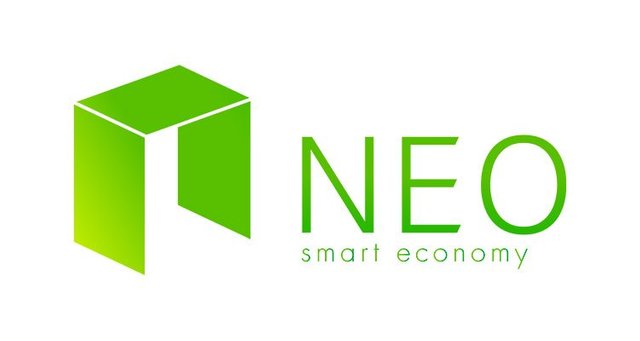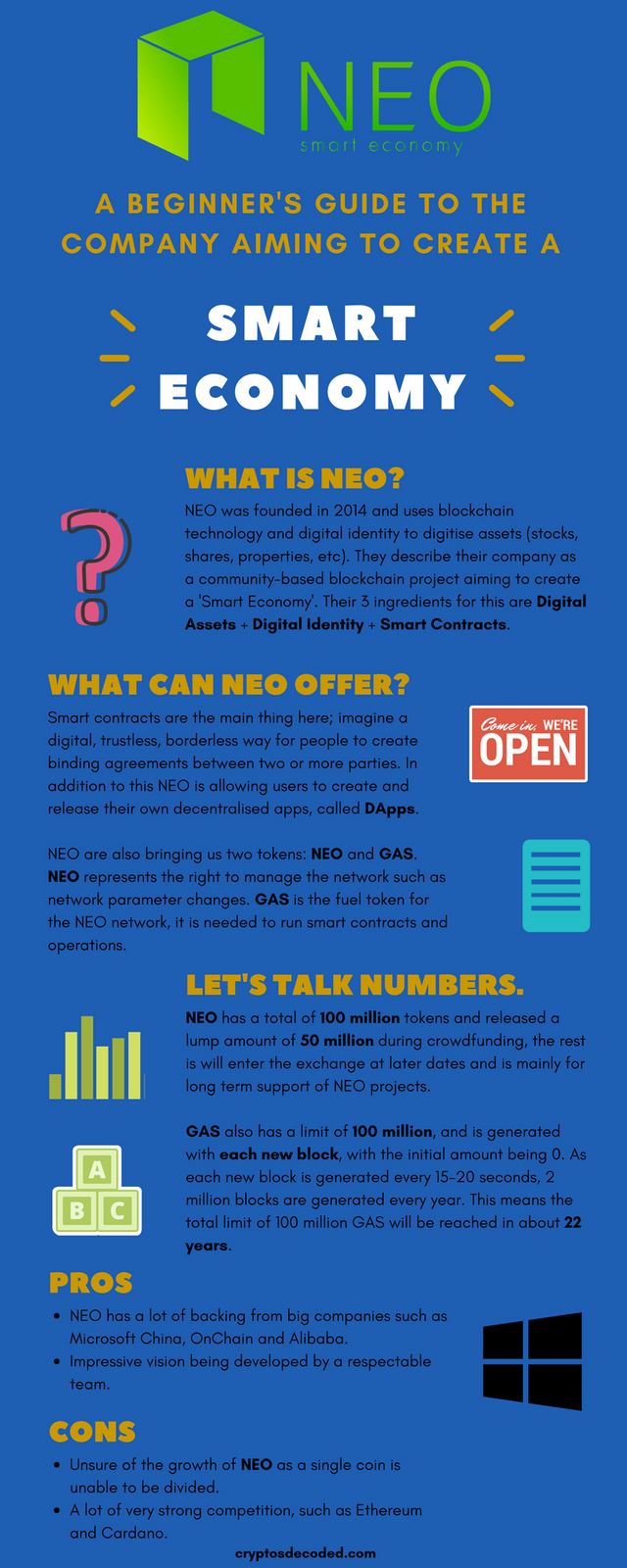What Is NEO And How Is It Different To Ethereum?

NEO is a company with a vision of a ‘Smart Economy’ through the mass adoption of the blockchain. Previously called ‘Antshares’ and now known as NEO, they are a non-profit, community based blockchain project who are aiming to create a smart economy that focuses on three main factors: Digital Assets, Digital Identity and Smart Contracts. What this means is, NEO is a platform for users to build decentralised, digitised resources and smart contracts on top of NEO’s blockchain. You probably already know that NEO is being compared to Ethereum, and it is true that to understand NEO it helps to have a basic understanding of how Ethereum works. However NEO is more robust in the sense that it works with already existing languages, yet with Ethereum you must learn a new coding language, Solidity, to write smart contracts and DApps.
The Basics of NEO
NEO was founded in 2014 by Da HongFei and was at that time known as ‘Antshares’, however in 2017 they rebranded to ‘NEO’. As previously mentioned NEO is working towards a smart economy through hosting smart contracts, providing initial coin offerings (ICOs) and allowing developers to build their own DApps on a decentralised system.
But what exactly is a smart economy?

These ‘Digital Assets’ that NEO talks about can be many things, from tokens, to Decentralised Apps (DApps), to property; they are programmable assets that exist in the form of electronic data. The ownership of these assets can be protected and validated through the decentralised layout of the blockchain.
The ‘Digital Identity’ can be thought of as any form of identification of individuals, organizations, and other entities that exist in electronic form. NEO plans to bring extra levels of security and verification to digital identities. They will use facial features, fingerprints, voice, SMS and other multi-factor authentication methods implemented on the blockchain to ensure that any form of identification is certifiably secure.
‘Smart Contracts’ were first proposed by the cryptographer Nick Szabo in 1994, only five years after the creation of the World Wide Web. According to Szabo’s definition: When a pre-programmed condition is triggered, the smart contract will execute the corresponding contract terms. By using blockchain technology, it will provide developers with a decentralized, tamper-resistant, highly reliable system in which smart contracts can be incredibly useful. NEO has their own independent smart contract system: NeoContract.
NEO GAS
NEO currently uses two different coins as its currency. It has the standard NEO token that works as a way to distribute the right to manage the NEO network. Think of this in the same way that proof of stake works or how Stratis uses their coin but using NEO’s own consensus algorithm called Delegated Byzantine Fault Tolerance. But instead of the reward being the NEO token, it is instead the GAS token. The NEO token is not divisible and will only ever exist in whole numbers. With each new NEO block verified a specific sum of GAS will be produced. Initially this will be 8 GAS per block, but this will reduced by 1 GAS each year and will continue until 100 million GAS are produced.
GAS is the secondary currency that is used as a “fuel” token for the network to run smart contracts and other applications. This is vital for people and companies that want to use the NEO network to build upon. So, if the NEO network increases and more and more companies start building upon it, the demand for GAS will increase. This is very good for NEO holders and is one of the main investment incentives.
The NEO coin has 100 million in total with 65 million currently in circulation. The rest are held by the developers for various reasons. This has raised some alarm bells with people as they see this as the developers having too much control and essentially centralising the currency.
NEO vs Ethereum
How is NEO different to Ethereum?
The main difference that NEO has compared to Ethereum is that is uses a collection of programming languages that are already widely used and known. Ethereum, on the other hand, uses its own programming language called Solidity that must be learned specifically for programming smart contracts and DApps on the Ethereum blockchain.
The languages that NEO is compatible with include: C#, F#, VB.NET, Kotlin, Java and Python. NEO are planning to incorporate the use of C, C++, Javascript and Golang in the future to add even more possibilities to their blockchain.
Being able to support many well known languages means that NEO is theoretically more accommodating to new developers and should therefore be a better place for developers to create their own products and services.
Whilst this does sound like a major positive, having a programming language, such as Solidity, can be very beneficial for a platform such as Ethereum or NEO. It can help to streamline the process of creating smart contracts and DApps, and only needs to be learnt once.
So far, Ethereum has been the clear winner in terms of user adoption. Currently the Ethereum blockchain has over 50% of the entire market share so will be difficult to beat. However, NEO does have a series of interesting new projects being built on the platform.
Onchain and Partners
One of Neo’s major partners is a company called Onchain. Onchain was founded by the creators of NEO and is aimed at providing consulting and development services to companies interested in blockchain technology. It is technically a separate entity to NEO but as one of the main features of NEO is its interoperability (the ability to connect different computer system, in this case blockchains) the users of NEO will be able to make use of the many benefits of Onchain as well. This is what NEO is calling NEOX. NEO and Onchain also have a very impressive list of partners including Microsoft China, Alibaba, the Chinese and Japanese Governments and FaDaDa.
History of NEO
Antshares was founded in February 2014 and was designed as a platform of building decentralised apps (DApps). It allowed for smart contracts to be created (similar to Ethereum) but uses more common programming language such as C#. Java and Python.
In 2016 the whitepaper for Neo’s delegated Byzantine Fault Tolerance (dBFT) was released. The dBFT was a new consensus protocol that is used instead of proof of work or proof of stake.
In 2017 Antshares was rebranded to Neo.
Team
The NEO team is most notably led by the co-founder Da Hongfei.

He is the also the founder of Onchain and both companies are based in China. In fact they were the first Chinese blockchain projects to be based in China.
Da Hongfei has earn great respect within the crypto community and is one of the leading pioneers of cryptocurrencies in Asia. He’s one of the leading minds in enterprise applications, regulations and user adoption. He also has a leading role as one of the Chinese governments consultants and has established a line of communication with government official during and in the wake of the Chinese ICO ban.
Another notable member of the team is Erik Zhang. He is the other co-founder of both Onchain and NEO and has worked with Da Hongfei to build up NEO to where it is today.
Trading Information
As mentioned before there are two cryptocurrencies that are available to buy under the NEO brand. The first is NEO Coin. The initial NEO Coin price was a very modest $0.18, since then it has risen buy huge amounts to a maximum of around $186! This huge rise in price was one of the reasons NEO has gained so much attention and is hovering around the top 10 cryptocurrencies in the world. Head to our post on Cryptos Decoded for a more detailed look.
How to Buy NEO Coin
The main NEO coin can be bought from many websites including:
- Upbit
- CoinEgg
- Bittrex
- Bitfinex
But we would recommend buying NEO coin from Binance. We’ve recently reviewed Binance and it is one of our favourite exchanges available today. What Binance also offers is the rewards from staking your NEO coin using their wallet. Binance is currently the only exchange that offers this, so adding that to the fact that it’s a great all round exchange and we’d highly recommend using only Binance to buy your NEO.
How to Store NEO Coin
Finding the best way to store NEO coin and NEO wallets in general can be a little confusing. There are many options which all have good points but we’ll give you what we think is the best way to go about it.
The official NEO desktop wallet, called NEON, is the best way to store NEO coin. The wallet is is easy to use and secure. Best of all, it allows you to earn your GAS rewards which some other wallets don’t.
If you’re looking for additional safety then we’d highly recommend picking up a Ledger Nano S and using it with the NEON wallet. This will add the extra layer of security that hardware wallets give whilst also allowing you to get your rewards.
If you’re looking for more convenience then you can always keep your NEO on the Binance exchange wallet and you’ll still be able to receive your GAS rewards. We’d generally advise against this as you’re not in control of the private keys and therefore it’s much less secure.
How to Buy NEO GAS
Buying GAS is a little trickier as there are less options available. But GAS is available on Binance and is therefore what we would recommend you use to buy. There are no rewards for holding GAS as it is the currency used to run the network so is seen less of an investment opportunity.
GAS can be stored in the same way as the standard NEO coin.
NEO Competitors
The main competition to the NEO cryptocurrency is from Ethereum but there are many others projects out there that are aiming to do very similar things. Cardano, EOS, Lisk and even QTUM are all potential competitors to NEO and they are all in the top 20.
The DApp and blockchain as a service market should be big enough for many platforms to survive but competition will always be very fierce.
Our Opinion on NEO
We think NEO is a very interesting project with some incredible backing from highly influential partners that would well see it become one of the leading companies in its sector, especially with the Chinese and other Asian markets. There are a lot of very interesting ideas developing from the developers and NEO has a lot of potential both as a company and an investment opportunity.
Pros and Cons
Pros
- Great list of partnerships including Microsoft, Alibaba and Onchain. The affiliation with the Chinese and Japanese governments is also a huge plus as it will likely be easier for NEO to survive through any potential new Chinese regulations.
- The development team and the current and past development prospects, such as smart contracts and the digital assets and identities could be hugely popular and important in the future.
Cons
- A lot of very strong competition. There is room in the market for several similar companies but it will be hard for NEO to cement themselves as one of them.
- As the NEO coin becomes more expensive, the fact that it isn’t divisible could prove problematic and the NEO to GAS ratio may make further investing less inviting.
Conclusion
Overall, NEO is a very interesting project with a lot of backing and it’s aiming to solve many problems. We think that if it starts to gain some traction and other companies begin to use it over Ethereum then it will have a very positive future.
NEO is a very complex project and we’ve only just scratched the surface with this beginner’s guide. For more NEO coin news follow our Facebook and Twitter and keep up to date with the rest of Cryptos Decoded as we expect to be posting more on NEO in the near future.
Infographic
